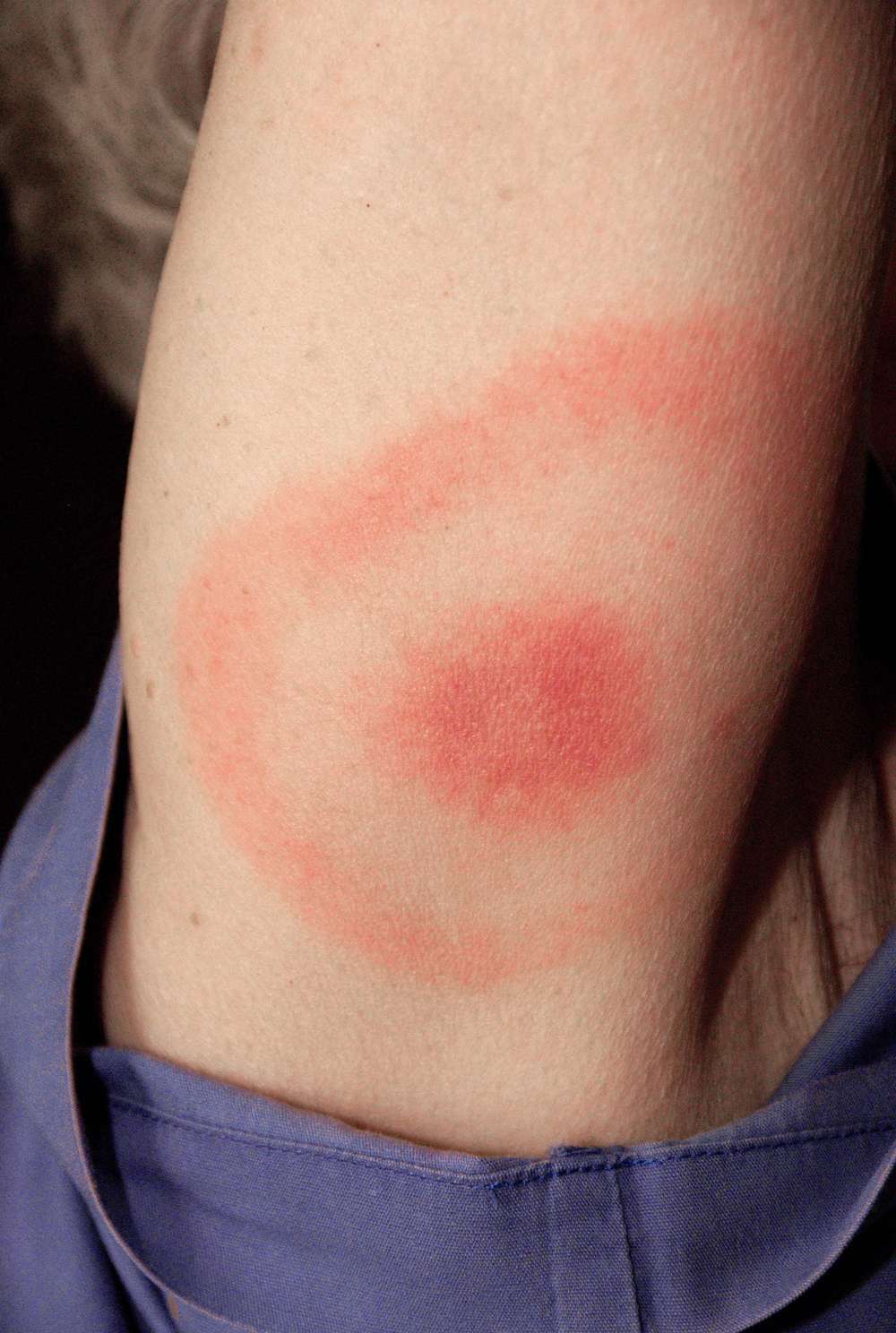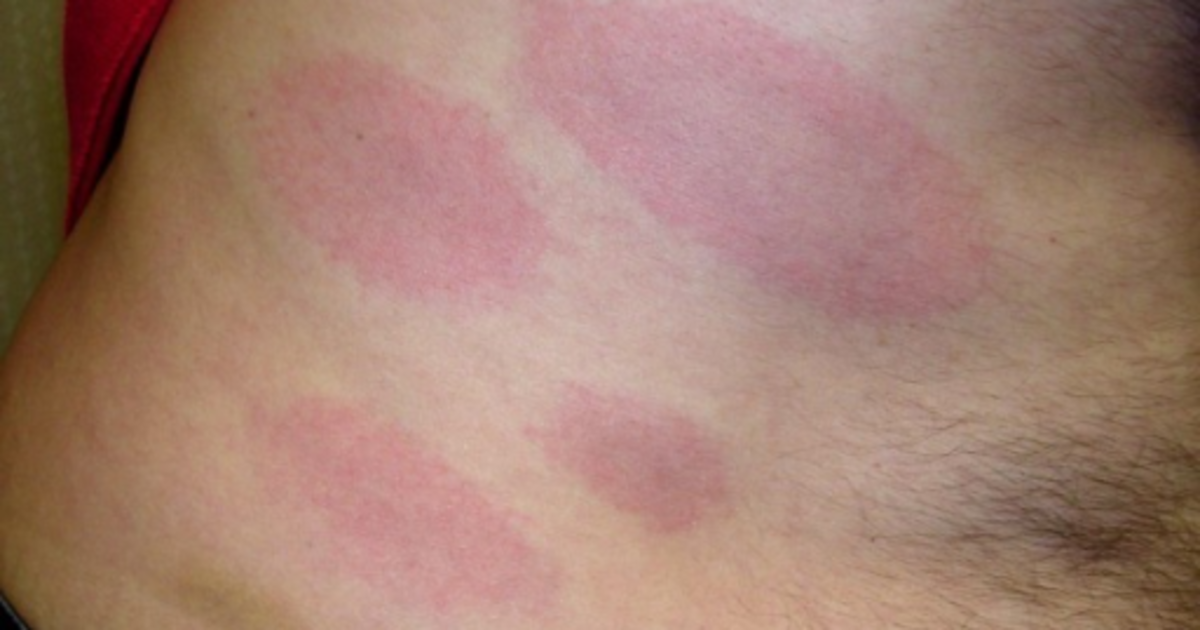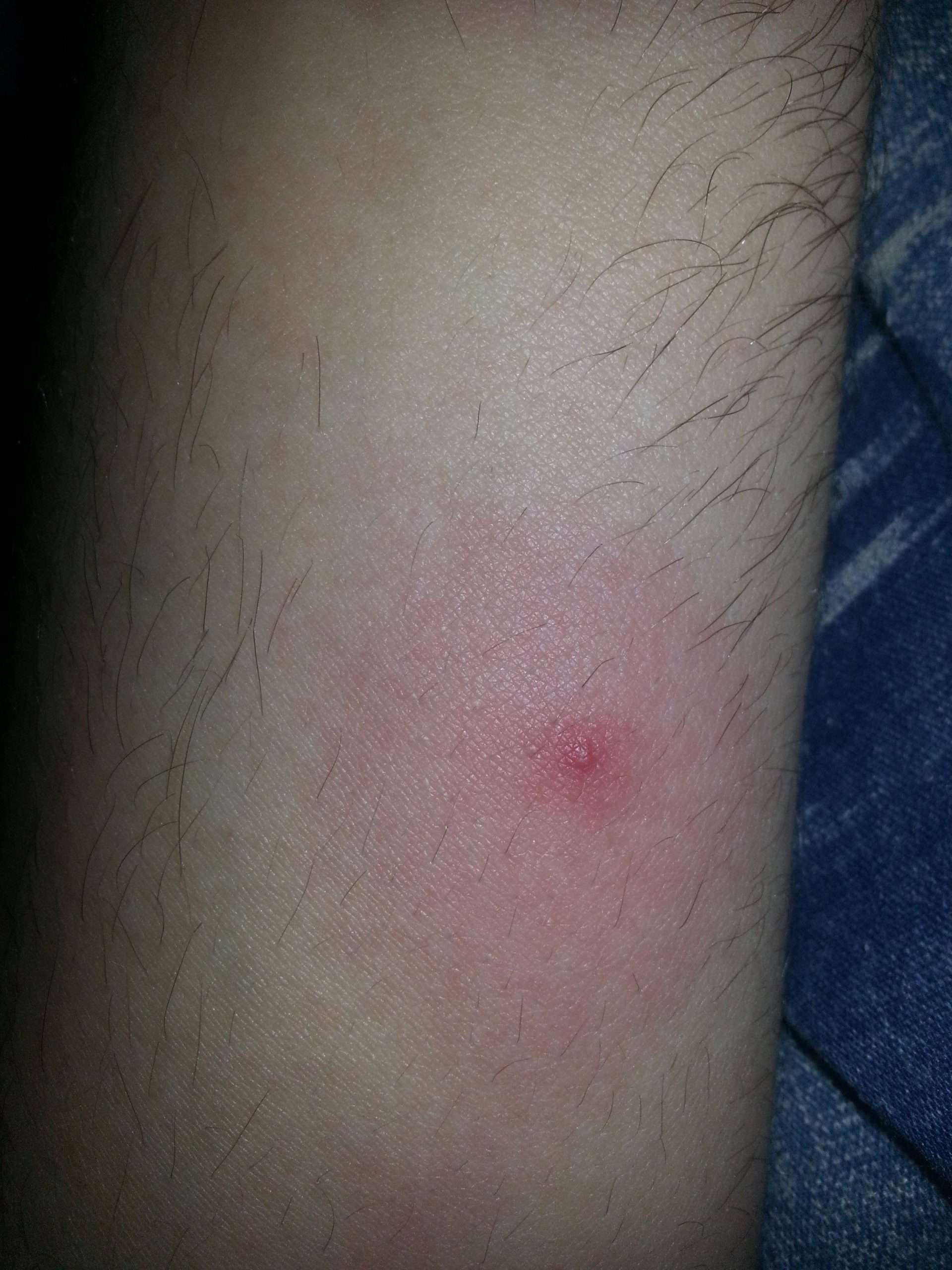What To Do If You Have A Blacklegged Tick Bite
Remove the tick by pulling it directly out with fine-tipped tweezers. Lift upward with slow and even pressure. Dont twist when removing it. Dont crush it or put soap or other substances on it. Dont apply heat to it.
Place the tick in a resealable container. See if you can identify what kind of a tick it is.
Immediately after removing the tick, wash your skin well with soap and water or with rubbing alcohol.
Not all ticks carry Lyme. The Lyme bacteria is transmitted only by blacklegged ticks in their nymph or adult stage.
Save the tick to show your doctor. The doctor will want to determine if its a blacklegged tick and if theres evidence of feeding. Ticks enlarge as they feed. Your risk of getting Lyme from an infected tick increases with the length of time that the tick fed on your blood.
Summary:
Pull the tick out with tweezers and save it in a resealable container for identification.
Stage : Quickly Expanding Rash
After being bitten by a black-legged tick, a quickly growing rash can appear. This is the earliest stage of Lyme disease, known as stage 1.
Most people who develop a rash, get it within days or weeks of being bitten by a tick.
Where you see the rash: If you develop a rash, it appears near the tick bit you. For most people, that means the back, groin, armpit, or a lower leg. However, a tick can bite you anywhere.
What the rash can look like: You may see a spot or bump on the skin, which is the bite mark. Around or near the bite mark, a rash develops. Some people see the bulls-eye rash . You can also have one of the other rashes shown here.
Early rash caused by Lyme disease
Notice the bite mark in the center of this early rash, which will expand quickly.
Bull’s-eye rash on woman’s upper arm
This is another early sign of Lyme disease.
Lyme disease rash with lighter color on the outside
This rash has expanded, but you can still see the bite mark in the center.
Rash from Lyme disease has begun to clear
As the rash begins to clear, the redness fades.
If you develop a rash during this stage, you may notice that it:
-
Feels smooth and warm to the touch
-
Causes a burning sensation
-
Itches or feels painful
-
Has an outer edge that feels scaly or crusty
When the rash and symptoms begin: According to the Centers for Disease Control and Prevention , the rash begins 3 to 30 days after the tick bites you.
About 50% of people who have Lyme disease develop flu-like symptoms , which include:
Stage : Late Disseminated Lyme Disease
Late disseminated Lyme disease occurs when the infection hasnt been treated in stages 1 and 2. Stage 3 can occur months or years after the tick bite.
This stage is characterized by:
- arthritis of one or more large joints
- brain disorders, such as encephalopathy, which can cause short-term memory loss, difficulty concentrating, mental fogginess, problems with following conversations and sleep disturbance
- numbness in the arms, legs, hands, or feet
Also Check: What Helps Lyme Disease Symptoms
The Chance Of Getting Lyme Disease
Not all ticks in England carry the bacteria that causes Lyme disease.
But its still important to be aware of ticks and to safely remove them as soon as possible, just in case.
Ticks that may cause Lyme disease are found all over the UK, but high-risk places include grassy and wooded areas in southern and northern England and the Scottish Highlands.
Ticks are tiny spider-like creatures that live in woods, areas with long grass, and sometimes in urban parks and gardens. Theyre found all over the UK.
Ticks do not jump or fly. They attach to the skin of animals or humans that brush past them.
Once a tick bites into the skin, it feeds on blood for a few days before dropping off.
How To Prevent Lyme Disease From Progressing

Learn the symptoms of early Lyme disease so that you can seek treatment promptly if you contract the infection. If you get timely treatment, you can avoid the potential complications of early disseminated Lyme disease and later stages.
The symptoms of early Lyme disease can occur between 3 and 30 days after an infected tick bites you. Look for:
- rash, such as:
- a red, expanding bulls-eye rash at the site of the tick bite
- a round or oval rash that can be as wide as 6 to 8 inches
You May Like: Lyme Disease And Facial Paralysis
Lyme Disease Can Affect Nearly Every Component Of The Human Body Resulting In Drastic Chemistry Change
| Unfortunately, since Lyme Disease is a biological hijacking , the chemistry of the body changes. The body develops new requirements, intolerances, and reactions to environments and substances that normally didn’t bother or disrupt the physiology of the body before obtaining the Lyme bacteria. These newfound intolerances and triggers can actually make a person with Lyme feel just as bad as they do during a herxheimer reaction, if not worse. And experiencing one of these triggers or intolerances at the same time as a herxheimer reaction can be the difference between having a bad day, and a really bad day. |
Don’t Panic If You Find A Tick
“If you find a tick on your child, do not panic,” Dr. Jacobs exclaims. “If the tick is not attached to the skin and is not engorged, then it hasn’t bitten your child and you don’t need to worry. Even if it has bitten through, most tick bites do not end up spreading any disease at all, and the risk of your child getting Lyme disease is still very, very low. Second, note the color of the tick, take a high-resolution photo of it, and plan to try to keep the tick once it’s removed, as that information could help identify what type of tick it is.”
Don’t Miss: How Do Doctors Treat Lyme Disease
Learn The Stages Of Lyme Disease
Lyme disease occurs in three stages: early localized, early disseminated and late disseminated. However the stages can overlap and not all patients go through all three. A bulls-eye rash is usually considered one of the first signs of infection, but many people develop a different kind of rash or none at all. In most cases, Lyme symptoms can start with a flu-like illness. If untreated, the symptoms can continue to worsen and turn into a long-lived debilitating illness.
Stage 1: Early Localized Disease
Symptoms with early localized Lyme disease may begin hours, a few days or even weeks after a tick bite. At this point, the
infection has not yet spread throughout the body. Lyme is the easiest to cure at this stage.
Symptoms may include:
- skin rash, which may or may not look like a bulls eye
- flu-like illness, including chills and fever
- fatigue
- muscle soreness and joint pain
- swollen lymph nodes
- sore throat
Stage 2: Early Disseminated Lyme
Early disseminated Lyme may occur several weeks or months after the tick bite. Bacteria are beginning to spread throughout the body. In addition to flu-like symptoms, this stage is often characterized by increase in symptoms such as:
- chills
- pain, weakness or numbness in the arms, legs
- vision changes
- heart problems, such as palpitations, chest pain
- rash may appear on body
- facial paralysis
Stage 3: Late Disseminated Lyme Disease
Related Content
Find a LLMD
Lyme Symptom Tracker App
Get started with your diary
What Does Lyme Feel Like
A patients experience.
How often do you as a Lyme patient get asked this question? It is an innocent question from people who are curious, some even genuinely wanting to know because they care. But how do you answer? Lyme is so complex. It changes day by day, even minute by minute.
I will share my typical day as a Lyme patient below. Feel free to share yours in the comment section below.
Please remember that each day and each moment can be different. With chronic Lyme, symptoms change constantly, their locations, their duration, their strength. It all changes constantly.
Read Also: Best Herbal Treatment For Lyme Disease
Lyme Disease Joint Pain And Arthritis
Lyme disease and joint pain unfortunately go hand in hand, as Lyme-related arthritis is commonly found in Lyme disease sufferers. If you have Lyme arthritis, you have swollen, painful joints that cause stiffness and pain. It is found in people who are in the late stages of Lyme disease. According to an article in Science Daily, approximately 60 percent of patients with untreated Lyme disease will develop related arthritis.
Lyme arthritis is caused by the bacteria that causes Lyme disease getting into your joints and causing inflammation of your tissues. Over time, this can cause damage to your cartilage. Most cases of Lyme arthritis are short-lasting and affect only one large joint.
Lyme arthritis can affect your:
- Knees
- Elbows
- Shoulders
In the U.S., its estimated that about 60 percent of untreated Lyme disease patients will experience intermittent episodes of swelling and lyme disease joint pain for months to years after they are infected by a tick bite.
Thankfully, most Lyme arthritis cases can be treated with antibiotics and NSAIDs, although some people may require surgery to remove some diseased tissue. Around ten percent of untreated patients may go on to develop chronic arthritis, reports Johns Hopkins Arthritis Center.
What Happens If You Go Untreated For Lyme Disease
Lyme disease is most dangerous from May to September, when young ticks are most likely to bite. The bacteria can cause flu-like symptoms in humans, and if left untreated, it can attack many tissues, including the heart and nervous system, and trigger an immune response that can lead to Lyme arthritis.
You May Like: Pictures Of Tick Bites With Lyme Disease
Recommended Reading: What Are The Symptoms Of Lyme Disease In Dogs
Key Points To Remember
- Most Lyme disease tests are designed to detect antibodies made by the body in response to infection.
- Antibodies can take several weeks to develop, so patients may test negative if infected only recently.
- Antibodies normally persist in the blood for months or even years after the infection is gone therefore, the test cannot be used to determine cure.
- Infection with other diseases, including some tickborne diseases, or some viral, bacterial, or autoimmune diseases, can result in false positive test results.
- Some tests give results for two types of antibody, IgM and IgG. Positive IgM results should be disregarded if the patient has been ill for more than 30 days.
What Can Be Done To Prevent Lyme Disease Flare

The first key to living with Chronic Lyme disease is finding a doctor and treatment regimen that works for you. Treatment and methods of prevention through lifestyle are different for every patient. However, there are some general guidelines, which anyone with Chronic Lyme could follow to promote a healthier lifestyle and thus, less flares.
Lyme disease is a sad fact of the world we live in. Chronic sufferers face a lifetime of health maintenance and treatment. Lyme disease flare-ups can really affect physical and emotional well-being.
Consider year-round tick control for the prevention of Lyme, and seek immediate medical attention if you believe you have been bitten by an infected tick.
Don’t Miss: Lyme Disease And Leg Cramps
What Are The Symptoms Of Chronic Lyme Disease
Home » Tick Talk » What Are the Symptoms of Chronic Lyme Disease?
Despite some skepticism in the medical community, chronic Lyme disease is a growing epidemic in the U.S. This stems partly from the shortcomings of many of the officially recommended Lyme disease tests, which leave too many patients with untreated infections that then become persistent and debilitating.
The following article will cover what you should know about chronic Lyme and provide an introductory but non-exhaustive chronic Lyme disease symptoms checklist.
Symptoms I Have Experienced
bladder pain * burning nerves * stabbing sensations * heart rhythm irregularities* chest pain like someone kicked in my sternum * confusion * apathy * anxiety * difficulty making myself think* cant concentrate * troubles speaking * cant think of word * pain * getting lost going somewhere familiar * leg pain * arm pain * head pressure * insomnia * fatigue * cant drink alcohol random hives on legs * vision is messed up * numbness in legs and arms * weakness everywhere * paralyzed feeling * head pressure * neck, back and shoulder pain * pelvic pain * rectal pain * tremor * visible shaking * seizure like activity * TIA * menstrual problems leading to hysterectomy * twitching * need to lay down suddenly * fainting * low blood pressure * vertigo * facial flushing * hallucinations * rage-like anger * paranoia * dark thinking * panic attacks * agoraphobia * trouble swallowing * unexplained bruising * sound sensitivity * heat intolerance * cold intolerance * dizziness *
These are the symptoms I thought of just off the top of my head.
Also Check: Lyme Literate Doctors In Ct
Can’t Get Better 4 Signs Your Aches & Pains Could Be Lyme Disease
Lyme disease is the number one vector-borne epidemic in the world and mimics many common diseases and autoimmune illnesses. If you’ve been told that you suffer from chronic fatigue syndrome, fibromyalgia, an autoimmune disease like MS, or are just “getting old, it is possible that you suffer from the number one infectious cause of these symptoms.
The Center for Disease Control released data showing a tenfold increase in the number of cases of Lyme disease, with approximately one million Americans reported having been exposed to it in 2012. So if you go to a doctor complaining of fatigue with joint and muscle pain, and have a negative blood test, it’s possible you may have contracted Lyme disease. How can you know whether you have a tick-borne illness causing your symptoms, though? Here are four signs to watch for:
How You Get Lyme Disease
If a tick bites an animal carrying the bacteria that cause Lyme disease, the tick can become infected. The tick can then transfer the bacteria to a human by biting them.
Ticks can be found in any areas with deep or overgrown plants where they have access to animals to feed on.
Theyre common in woodland and moorland areas, but can also be found in gardens or parks.
Ticks dont jump or fly. They climb on to your clothes or skin if you brush against something theyre on. They then bite into the skin and start to feed on your blood.
Generally, youre more likely to become infected if the tick is attached to your skin for more than 24 hours. Ticks are very small and their bites are not painful, so you may not realise you have one attached to your skin.
Also Check: What Does The Rash Of Lyme Disease Look Like
Can Lyme Disease Have Flare
In short, yes Lyme disease generally comes with flare-ups. One initial flare-up of symptoms can occur at the beginning of treatment and is referred to as a Herxheimer reaction. This reaction occurs when the dying bacteria releases certain toxin-like substances that cause symptoms to reappear.
Other types of flare-ups can occur long after treatment, and the existing symptoms that a person experiences with Lyme disease may recur or worsen. When flare-ups occur in someone with chronic Lyme disease, its typically because they havent sought treatment for more than a year after an initial infection, or because they had been previously prescribed steroids prior to getting diagnosed with Lyme disease.
Image by Ayo Ogunseinde on a: Can you have a relapse of Lyme disease?
Stage : Early Localized Disease
Symptoms of Lyme disease usually start 1 to 2 weeks after the tick bite. One of the earliest signs of the disease is a bulls-eye rash.
The rash occurs at the site of the tick bite, usually, but not always, as a central red spot surrounded by a clear spot with an area of redness at the edge. It may be warm to the touch, but it isnt painful and doesnt itch. This rash will gradually fade in most people.
The formal name for this rash is erythema migrans. Erythema migrans is said to be characteristic of Lyme disease. However, many people dont have this symptom.
Some people have a rash thats solid red, while people with dark complexions may have a rash that resembles a bruise.
The rash can occur with or without systemic viral or flu-like symptoms.
Other symptoms commonly seen in this stage of Lyme disease include:
Recommended Reading: Oxygen Therapy For Lyme Disease
Do All Ticks Transmit Lyme Disease
No. In the northeastern and north-central U.S., the black-legged tick carries Lyme disease. In the Pacific coastal U.S., the western black-legged tick spreads the disease.
Other major tick species in the U.S., like the lone star tick and the dog tick, do NOT transmit the Lyme disease bacterium. But beware: All 50 states have reported Lyme disease, as well as Canada, Europe, Asia, Australia, and South America.
Symptoms Of Early Stage Lyme Disease

According to the Centers for Disease Control and Prevention , early-stage Lyme disease symptoms crop up within 3 to 30 days after exposure and can include but are not limited to:
- Fever
- Swelling of the lymph nodes
- Erythema migrans , a bulls-eye-shaped rash that appears at the site of the tick bite
Early Lyme disease does not always appear the same in all patients. For example, up to 30% of patients dont remember experiencing a bulls eye rash.
Also Check: Can Lyme Disease Cause Bell’s Palsy